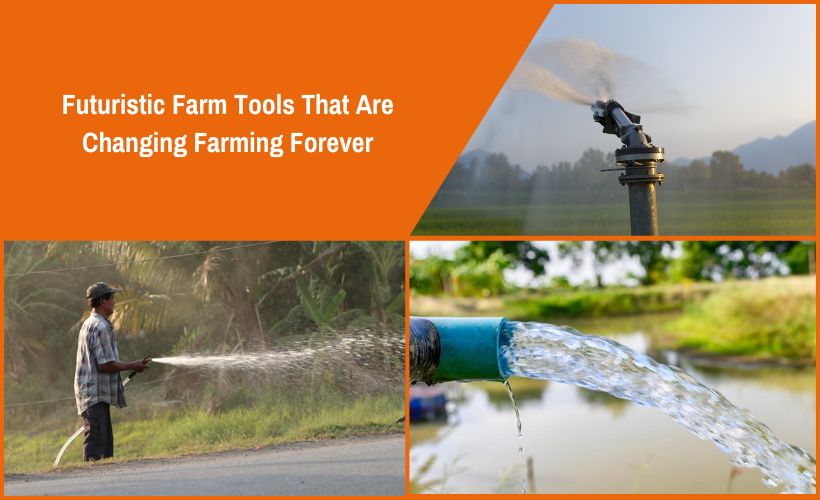Agriculture, the backbone of human civilization, is experiencing a groundbreaking transformation. The reliance on manual labor and traditional farming techniques is being replaced by smart technology and innovative machinery. These advancements are enhancing efficiency, sustainability, and productivity. Additionally, the use of farm water pump technology ensures better irrigation practices, reduces water waste, and improves overall crop health. Let’s explore the futuristic farm tools and technologies that are reshaping the agricultural landscape.
How Smart Technology is Changing Agriculture Forever
The integration of smart technology into agriculture, often referred to as “precision agriculture,” is revolutionizing farming methods. Sensors, drones, and data analytics provide farmers with real-time insights, allowing them to make informed decisions and optimize their operations.
1. Sensors and IoT
Soil moisture sensors, weather stations, and plant health monitors deliver continuous data on essential parameters. This helps farmers optimize irrigation, fertilization, and pest control, reducing resource waste and maximizing crop yields. For instance, advanced diesel water pump for agriculture systems are playing a crucial role in providing efficient irrigation in remote farming locations.
2. Drones and Remote Sensing
Drones equipped with high-resolution cameras and multispectral sensors capture aerial images of fields. These images reveal crucial details about crop health, weed infestations, and soil conditions, allowing for targeted interventions and reducing the need for broad-spectrum treatments.
3. Data Analytics and AI
Advanced algorithms and machine learning models analyze vast amounts of agricultural data to identify patterns, predict yields, and optimize resource allocation. This empowers farmers to make data-driven decisions, improving efficiency and profitability. The use of agricultural irrigation water pump solutions further enhances the ability to distribute water efficiently, optimizing irrigation processes.
4. Automated Systems
Robotic harvesters and automated irrigation systems are streamlining labor-intensive tasks. This automation allows farmers to focus on strategic planning and management, enhancing overall productivity. Many farmers are now incorporating agriculture motor pump solutions into their automated irrigation systems to ensure an uninterrupted water supply.

5 Modern Farming Machines That Are Transforming Agriculture
The advent of advanced machinery has significantly improved agricultural productivity. Here are five modern farming machines that are revolutionizing the industry:
1. Autonomous Tractors
Self-driving tractors use GPS, sensors, and AI to navigate fields and perform tasks such as planting and tilling with precision. They operate 24/7, reducing labor costs and increasing efficiency.
2. Robotic Weeders
These machines utilize computer vision and AI to identify and remove weeds without relying on harmful herbicides, promoting sustainable farming and minimizing environmental impact.
3. Automated Harvesters
Automated harvesters efficiently collect crops with minimal losses, improving product quality. They are particularly beneficial for harvesting delicate crops like fruits and vegetables.
4. Precision Sprayers
Using sensors and GPS technology, precision sprayers apply pesticides and fertilizers only where needed, reducing chemical usage and minimizing environmental impact.
5. Vertical Farming Systems
Although a system rather than a single machine, vertical farming utilizes hydroponics or aeroponics to grow crops indoors. This maximizes space and conserves resources, making it a sustainable alternative to traditional farming.
5 Agricultural Machines That Will Change Farming Forever
In addition to the previously mentioned machines, several more are set to revolutionize agriculture:
1. Seed Planting Robots
These robots precisely plant seeds at optimal spacing and depth, ensuring uniform germination and maximizing yields while reducing seed waste.
2. Livestock Monitoring Systems
Equipped with sensors and cameras, these systems monitor livestock health and behavior, enabling early disease detection and improved animal welfare.
3. Soil Mapping Systems
Utilizing sensors and GPS, soil mapping systems create detailed maps of soil properties. This information helps farmers optimize fertilization and irrigation practices.
4. AI-Powered Crop Monitoring Drones
These advanced drones not only capture images but also process them in real-time using onboard AI. They instantly detect diseases, pests, and nutrient deficiencies, allowing for immediate action.
5. Modular Farming Systems
Designed for scalability and adaptability, modular farming systems enable farmers to customize their operations based on specific needs. They are suitable for a wide range of crops and livestock.
Efficient Water Management with Advanced Pumps
Efficient water management is crucial for modern farming. The use of a diesel water pump for agriculture helps ensure proper irrigation, reducing water waste and improving crop yields. These pumps allow farmers to distribute water effectively, even in remote or dry areas, enhancing agricultural productivity.

Conclusion
The future of farming is driven by innovation and technology. As these futuristic farm tools and technologies continue to evolve, agriculture will witness even greater improvements in efficiency, sustainability, and productivity. By embracing these advancements—including smart irrigation solutions like agriculture motor pumps—farmers can secure a more sustainable and abundant food supply for generations to come.
FAQ
Q1. What is the future scope of smart farming?
Smart farming is the future of agriculture. It is an approach to farming that uses technology to increase yields, improve efficiency, and reduce inputs. Smart farming includes the use of sensors, GPS, and other data-driven techniques to optimize crop production. The goal of smart farming is to produce more with less.
Q2. What is the most important farm tool?
1. Tractors. The tractor is ubiquitous in the farming world and comes in various sizes to fit any farming operation. The primary purpose of a tractor is to pull farm equipment, but modern tractors can be outfitted with multiple attachments to suit just about any farming need.




